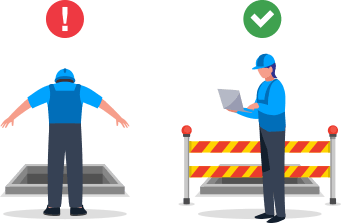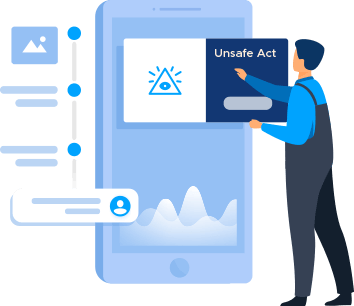What is Safety Observation?

What are safety observations?
Safety observations are a valuable tool for identifying potential hazards and risks in the workplace. By regularly conducting safety observations, organizations can proactively address potential safety issues before they cause harm or accidents. This can help to prevent workplace injuries and illnesses, as well as reduce the risk of financial losses due to workplace accidents.
Additionally, safety observations can help to promote a safety-conscious culture within the organization, which can help to improve overall morale and productivity. Overall, the benefits of safety observations include improved safety, reduced risk, and increased productivity and morale.
A safety observation report typically includes the person who had made the observation, date and time of the observation, the location of the hazard, a description of the hazard, a photograph of the hazard, severity level and any recommended actions to address the issue. The goal of a safety observation report is to identify and address potential hazards before they cause injuries or accidents.
Watch Safetymint in action
5 key benefits of conducting safety observations
There are several benefits of conducting safety observations in the workplace, including:

What are some examples of safety observations:
Safety observations can be conducted in a variety of settings and situations, and may focus on a wide range of potential hazards and risks. Some examples of safety observations include:
- Observing workers to ensure that they are using Personal Pprotective Equipment (PPE) such as hard hats, gloves, and safety glasses
- Checking for trip hazards, such as loose cables or uneven flooring, in walkways and other areas where employees may be walking
- Observing the use of machinery and equipment to ensure that it is being operated safely and in accordance with manufacturer's instructions
- Checking for potential fire hazards, such as blocked exits or overloaded electrical outlets
- Observing workers to ensure that they are following safe lifting techniques when handling heavy objects.
Overall, the specific types of safety observations will depend on the specific workplace and the potential hazards and risks present.
Safety observations Vs Safety incidents – what are the main differences?
Safety observations and incidents are two different types of events that can occur in the workplace. Safety observations refer to the process of actively looking for and identifying potential hazards and risks in the workplace. This typically involves a trained observer looking for potential safety issues, and documenting any findings. Safety observations are proactive in nature, and are intended to help organizations identify and address potential hazards and risks before they result in an accident.

Incidents, on the other hand, refer to actual accidents, injuries, or other safety events that have occurred in the workplace. Incidents are typically reactive in nature, and are typically reported after the fact. Incidents may be the result of hazards that were not identified and addressed through safety observations, or may be caused by other factors such as human error or equipment failure.
In summary, the main difference between safety observations and incidents is that observations are proactive, while incidents are reactive. Safety observations are intended to help organizations identify and address potential hazards and risks, while incidents are typically reported after the fact.
What are the steps to encourage safety observations at work?
Encouraging safety observations at work involves a combination of communication, training, and support. Here are some steps that organizations can take to promote safety observations in the workplace.
Communicate the importance of safety observations: It is important for organizations to clearly communicate the importance of safety observations to employees. This can include sharing information about the potential benefits of conducting safety observations, such as improved safety and reduced risk.
Provide training on safety observations: In order for safety observations to be effective, employees need to understand how to conduct them properly. Organizations can provide training on the process and techniques for conducting safety observations, as well as on how to identify and assess potential hazards and risks.
Create a supportive environment: In order for employees to feel comfortable conducting safety observations, it is important for organizations to create a supportive environment. This can include providing employees with the tools and resources they need to conduct safety observations, as well as recognizing and rewarding employees who contribute to the organization's safety efforts.
Encourage participation: Organizations can encourage participation in safety observations by making it easy for employees to report their observations. This can include providing employees with a simple and user-friendly way to document their observations, as well as ensuring that their observations are reviewed and addressed in a timely manner.
By taking these steps, organizations can encourage employees to actively participate in the safety observation process, and help to improve safety and reduce risk in the workplace.
How can software help in safety observation?
Safety observation software like Safetymint can help organizations to streamline and automate the process of conducting safety observations. Software typically allows users to easily record and track safety observations, as well as manage and analyze the data collected. Using the mobile app, employees can report observations from anywhere, any time.
Some of the features commonly found in safety observation software include:
- A user-friendly interface for conducting and recording safety observations, including the ability to add notes, photos, and other relevant information
- The ability to categorize and prioritize observations based on factors such as risk level and location
- Tools for tracking and managing follow-up actions and corrections, including the ability to assign tasks and deadlines to relevant individuals or teams
- Reports and analytics tools for analyzing safety observation data and identifying trends and patterns
- Integration with other safety and health management systems, such as incident reporting and hazard management.

Overall, a safety observation software can help organizations to more efficiently and effectively conduct safety observations, and use the data collected to improve safety and reduce risk in the workplace.
Frequently Asked Questions:
Here are some common questions and answers about safety observations:
What is a safety observation?
A safety observation is a report that documents any potential hazards or unsafe conditions that are observed in the workplace. It typically includes the date and time of the observation, the location of the hazard, a description of the hazard, and any recommended actions to address the issue.
Why are safety observations important?
Safety observations are important because they provide a way for employees to report potential hazards and unsafe conditions. This allows the employer to identify and address potential hazards before they cause injuries or accidents. Additionally, safety observations can help identify trends and patterns in the workplace, allowing the employer to implement targeted safety interventions and training programs.
Who should conduct safety observations?
Safety observations can be conducted by anyone in the workplace, including employees, supervisors, and safety professionals. It is important that all employees receive appropriate training on how to conduct safety observations, and that they feel comfortable and empowered to report potential hazards.
How often should safety observations be conducted?
The frequency of safety observations will depend on the specific needs of the workplace. In general, it is recommended that safety observations be conducted regularly, on a daily or weekly basis, to ensure that potential hazards are identified and addressed in a timely manner.
What should be included in a safety observation report?
A safety observation report should include the date and time of the observation, the location of the hazard, a description of the hazard, and any recommended actions to address the issue. Some safety observation formats may also include a section for additional comments or notes. It is important that the report be completed accurately and in a timely manner, to ensure that the identified hazards can be addressed effectively.
How can technology help improve safety in an organization?
Technology can also be used to create safety observation checklists to collect and analyze safety data, allowing organizations to identify trends and patterns in workplace accidents and injuries.



